Text

The first Belgian Royal Family, at the center we can see the King Leopold I, his wife, Queen Louise Marie and their three surviving children, the Crown Prince Leopold (later Leopold II), Prince Philippe and Princess Charlotte (future Empress of Mexico), 1840's.
#king leopold ii of belgium#King leopold i of Belgium#queen louise marie of belgium#Prince Philippe of Belgium#princess charlotte of belgium#empress charlotte of mexico#empress charlotte#carlota amalia#empress carlota#belgian royal family#belgian royalty#royalty#1840s
9 notes
·
View notes
Text

Empress Charlotte and Emperor Maximilian of Mexico.
#princess charlotte of belgium#empress charlotte of mexico#empress charlotte#habsburg#royalty#carlota amalia#empress carlota#maximilian of mexico#archduke maximilian#Emperor Maximiliano
10 notes
·
View notes
Text
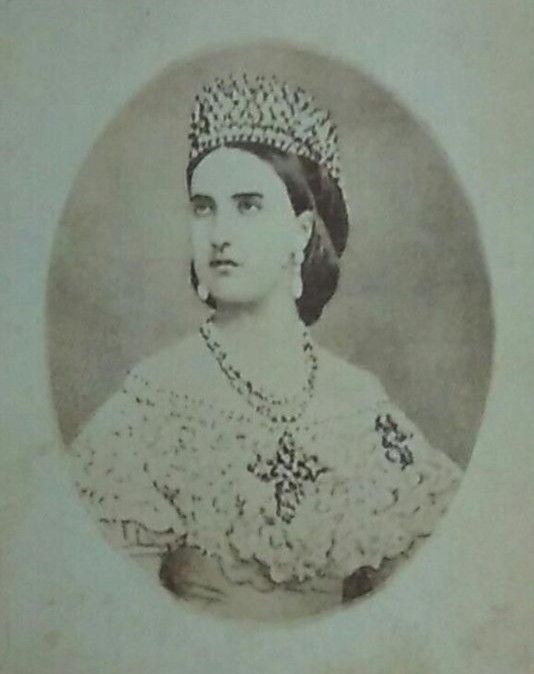
Empress Charlotte of Mexico.
#empress charlotte#empress charlotte of mexico#princess charlotte of belgium#habsburg#royalty#carlota amalia#empress carlota
4 notes
·
View notes
Text
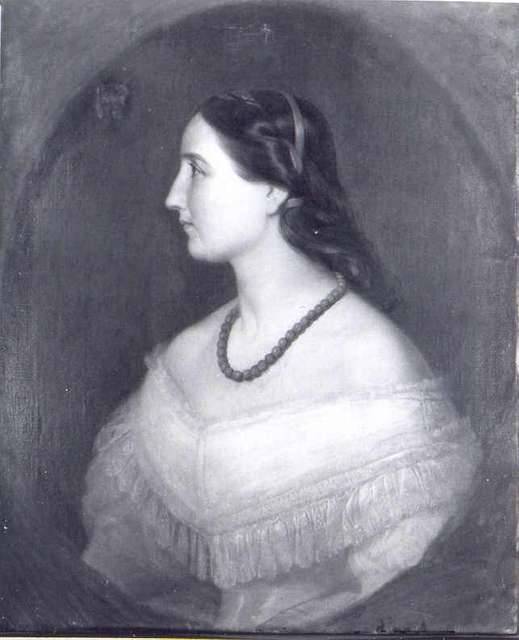
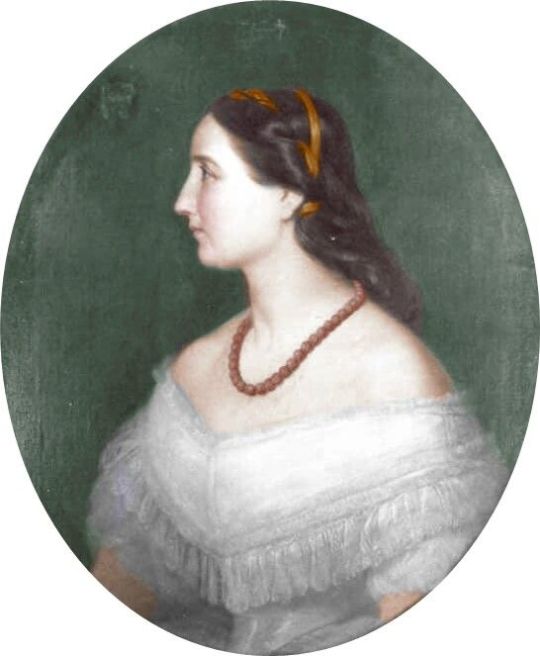

Portrait of Empress Charlotte of Mexico.
#empress charlotte#empress charlotte of mexico#princess charlotte of belgium#habsburg#royalty#carlota amalia#empress carlota
4 notes
·
View notes
Text
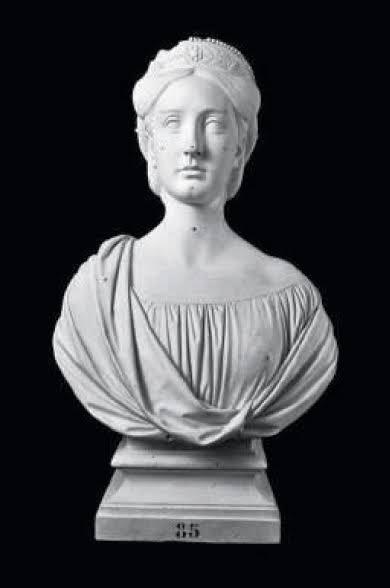
Marble bust of Empress Charlotte of Mexico.
#princess charlotte of belgium#empress charlotte of mexico#empress charlotte#habsburg#royalty#carlota amalia#empress carlota
4 notes
·
View notes
Text
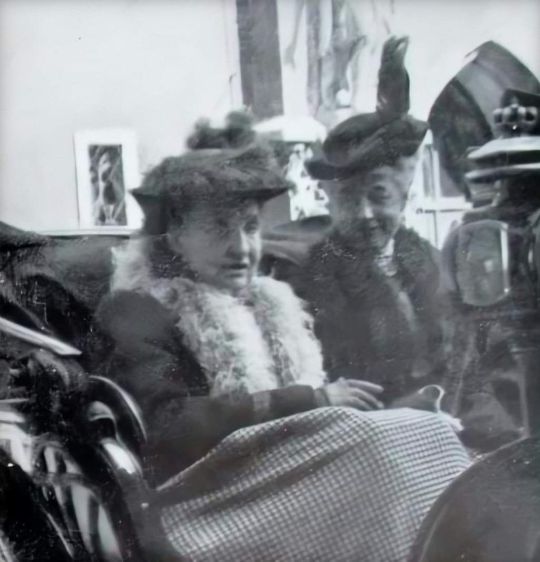

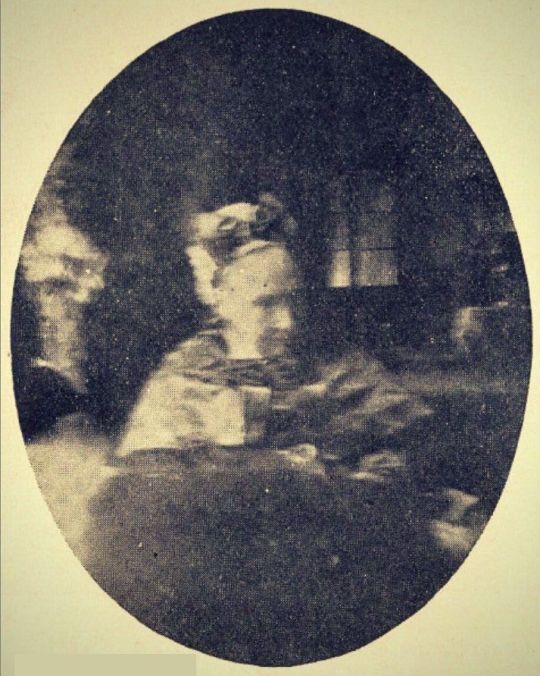
Three photos of Empress Charlotte of Mexico on the last years of her life, 1920's.
#empress charlotte#empress charlotte of mexico#princess charlotte of belgium#habsburg#royalty#carlota amalia#empress carlota
5 notes
·
View notes
Text
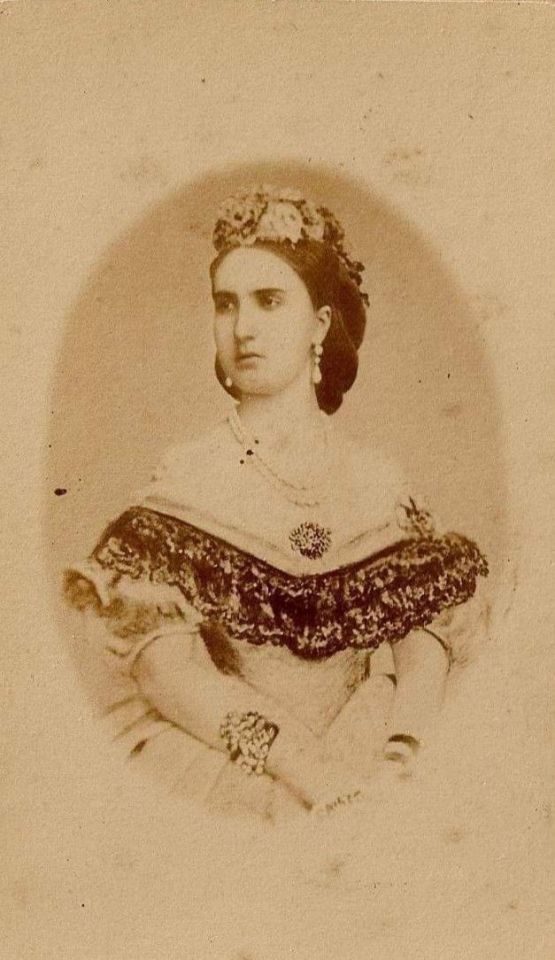
Empress Charlotte of Mexico.
#empress charlotte#empress charlotte of mexico#princess charlotte of belgium#habsburg#royalty#carlota amalia#empress carlota
2 notes
·
View notes
Text
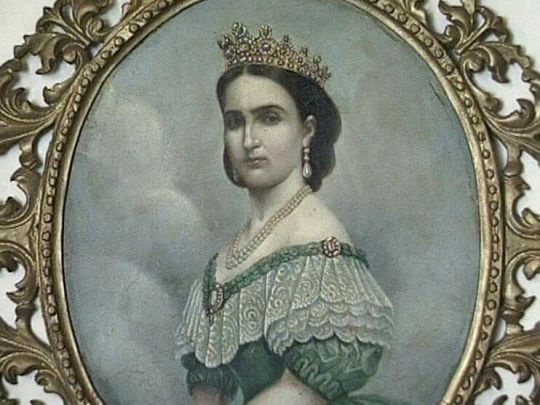
Empress Charlotte of Mexico.
#empress charlotte#empress charlotte of mexico#princess charlotte of belgium#habsburg#royalty#carlota amalia#empress carlota
0 notes
Text
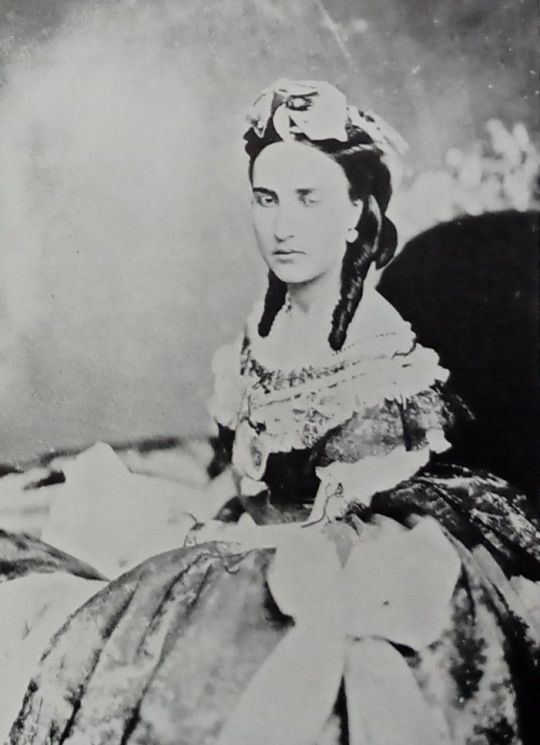
Empress Charlotte of Mexico.
#empress charlotte#empress charlotte of mexico#princess charlotte of belgium#habsburg#royalty#carlota amalia#empress carlota
2 notes
·
View notes
Text
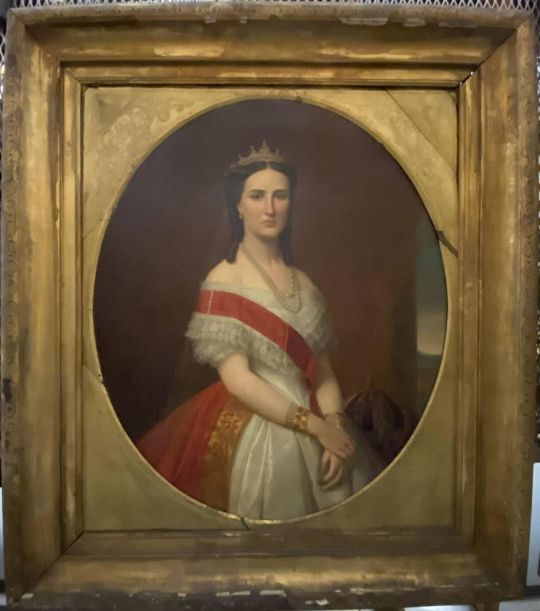
Empress Charlotte of Mexico, neé Princess of Belgium.
#empress charlotte of mexico#princess charlotte of belgium#empress charlotte#carlota amalia#empress carlota#habsburg#royalty
1 note
·
View note
Text

Empress Charlotte of Mexico.
#empress charlotte#empress charlotte of mexico#princess charlotte of belgium#habsburg#royalty#empress carlota#carlota amalia
0 notes
Note
Why didn't Sisi like Carlota of Mexico?
Hello anon! I'm really sorry that it took me so long to answer this question. It is a bit long and it took me a while to put it together, but I hope you find my answer helpful!
Long story short: they were pitted against each other. Charlotte not only was a very intelligent woman, at the time of her marriage to Archduke Max she was also considered a great beauty, more beautiful than Elisabeth (her father King Leopold referred to her as the prettiest princess of Europe - although all doting fathers think that of their daughters, so this is anything but an unbiased opinion lol). The Archduchess Sophie had nothing but praises towards Charlotte, and the Viennese court in general preferred her over the Empress. This made Sisi grew resentful of her sister-in-law, who in everyone's eyes was the perfect wife and daughter-in-law, unlike her. But there is more to it.
Elisabeth and the Archduke Max also got along really well, since they had more similar personalities. It may be that Charlotte was jealous of their closeness (and Franz Josef too). According to Joan Haslip's The Crown of Mexico, during their engagement Max gifted Charlotte, among other things, a portrait of Elisabeth. Who knows what she thought of that.
Sisi and Charlotte didn't start off great either: Max married Charlotte July 1857, only two months after the death of Archduchess Sophie Friederike, Sisi and Franz Josef's infant daughter. When Charlotte was to be introduced to the Imperial family they were still in mourning, but Franz Josef made the court come out of the mourning in order to held a gala reception at the Schönbrunn in Charlotte's honor. Elisabeth, who was still recovering from her daughter's sudden death, wasn't happy to leave her mourning to receive her new sister-in-law and it showed. Also according to Haslip, she left the reception in tears.
As I already mention, Elisabeth was likely jealous of everyone praising Charlotte while she was looked down. Charlotte was likely jealous of her husband's friendship with Elisabeth, but this one went both ways, since we have Elisabeth calling Charlotte "that pretentious little Coburg, who was always showing off her knowledge and was so boringly possessive with Max" (this quote is from Haslip's Crown of Mexico but she doesn't give a source and that drives me insane lol). Another thing that Haslip notes is that Charlotte apparently also looked down on Elisabeth for being "just" the daughter of a Duke in Bavaria, while she was the daughter of a King. Given that the ducal origins of Sisi were heavily judged by the Viennese court it wouldn't surprise me if this was the case.
When Elisabeth returned from her half-a-year-long stay on Madeira, she arrived in Trieste, where she reencontered with her husband, and her brother and sister-in-law (there is a painting by Cesare dell'Acqua depicting this moment that you may have seen). There is a story that, during her stay at Miramare, Max's castle in Trieste, Elisabeth's sheepdog attacked and killed Charlotte's little lapdog that had been a present from Queen Victoria. Allegedly, Elisabeth's reaction to Charlotte's grief was stating that she disliked small dogs.
Elisabeth and Charlotte were, in general, very different women, who wanted very different things: Elisabeth spent her whole life running away from her role as an empress, something that Charlotte wanted enough to support the Mexican enterprise. Elisabeth was totally against this, and she couldn't understand why would they want a Crown, let alone one so far away in such an unstable country. It seems that the genuine worry she felt about the fates of her brother and sister-in-law made Elisabeth soften towards Charlotte, because when she was in Mexico she wrote to Sisi a letter "thanking her for all the kindness she had shown her during the last visit [she made to Vienna]" (1965, Haslip).
Elisabeth and Charlotte saw each other only once after the Second Mexican Empire fell, Max was executed and Charlotte's mental health collapsed. Charlotte spent the rest of her life secluded in Belgium, almost forgotten by the rest of the world. When Crown Prince Rudolf became engaged to Princess Stephanie of Belgium, Charlotte's niece, in 1880, Sisi went to Brussels to congratulate them. After that, she went to visit the former Empress of Mexico. We don't know what they talked about during that visit, wheter Charlotte was concious or not, but that was the last time they saw each other. Charlotte died aged 86 in 1927, after being reclused for sixty years.
There is one more story, kinda impossible to check out, about Sisi and Charlotte. In 1891 Elisabeth visited Miramare with her Greek teacher Constantin Christomanos, where she allegedly said about the former Empress: "Thirty years of madness—a terror-haunted abyss, and yet I am told she is getting stout." If this story is true, then this is the last recorded time Elisabeth ever mentioned her forgotten sister-in-law.
So from what I could gather, there were several reasons for them to dislike each other rather than a single one. But mainly I think it was jealousy. I think that Crown Princess Stephanie put it down the best way on her memoirs: "there was also an outspoken dislike and jealousy between Charlotte and her sister-in-law, the Empress Elizabeth. It was impossible for these two beautiful women to shine in the same firmament."
51 notes
·
View notes
Text

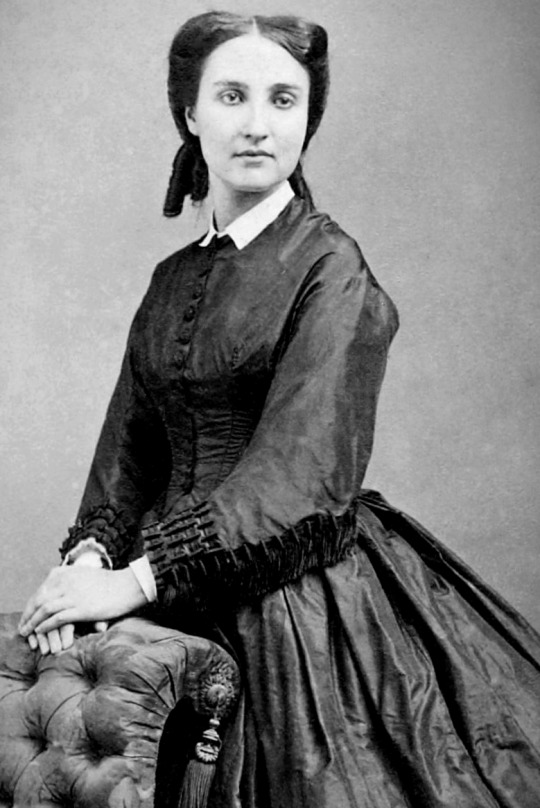
The last Queen of Naples and the last Empress of Mexico
Some weeks ago I finished a Haslip's biography on Maximilian and Charlotte, and one little tidbit that I found really interesting it's that during her stay at Rome, when Charlotte had her mental breakdown, she was visited by the deposed Queen and King of the Two Sicilies, Marie and Francesco. I looked it up but I couldn't find much more, so here is a compilation of all the quotes I found about it, from the oldest to the most recent:
A MELANCHOLY INCIDENT is related of the Empress of Mexico. Some little time ago, while still labouring under the delusion that she was being poisoned, she was visited by the Queen of Naples, and locking steadily at her, said, "Ah! how you are changed! I see they are also slowly poisoning you. What a change! What a change!" "Could anything," adds the Contemporary Review, "be more sad than such a meeting of the two unfortunate Queens?"
Dorset County Express and Agricultural Gazette, 11 December 1866
October 8, at noon, the Empress received the visit of the once King and Queen of Naples, who were at that time in Rome. They advised her to be calm and to eat and drink without fear. "Be careful not to let them poison you too", was the answer of the Empress.
Corti, Egon Caesar (1944). La tragedia de Maximiliano y Carlota
The King and Queen of Naples, who were living in exile in the Farnese Palace, were among the Empress’s first visitors, and Maria Sofia wrote to her sister Elisabeth in Vienna that they found Charlotte ‘in a state of nervous agitation, talking incessantly of poison’.
(...)
The following day, brother and sister were seen arm in arm touring the sights of Rome and Philippe was amazed at Charlotte’s knowledge of the churches. But the effort was too much for her tired brain, and after her farewell visit to the King and Queen of Naples, the Queen noted, ‘Poor Charlotte’s condition has sadly deteriorated.’
Haslip, Joan (1971). The Crown of Mexico: Maximilian and his Empress Carlota
On October 9 the Empress and the Count of Flanders left the hotel arm in arm for the railroad station. The King and Queen of Naples came to see them off and tried to calm her, saying she should not be afraid to eat or drink. She replied that they should be careful; the poisoners were everywhere; they had poisoned her mother and father, Albert Prince Consort, Lord Palmerston, many others.
Smith, Gene (1974). Maximilian and Carlota: the Habsburg tragedy in Mexico
As you can see, they are all kinda similar. I couldn't find more info about what kind of relationship Marie and Charlotte (and Francesco too, let's not forget about him) had before this, but I assume they weren't close at all, given that this seems to be their only recorded interaction. In any case, I agree with the first quote: this was a sad meeting.
27 notes
·
View notes
Text

At eight o'clock on the morning of Saturday, 9 April, the Imperial train with Franz Josef on board drew up at the private station at Miramar, where Maximilian was waiting to receive him. The Emperor was accompanied by an impressive retinue: seven Archdukes, including his two brothers, Karl Ludwig and Ludwig Viktor; three ministers, one of them Count Rechberg; the Chancellors of Hungary, Croatia and Transylvania; the Chief of the General Staff and the civil and military governors of Venetia and of Istria, accompanied by a bevy of secretaries and aides-de-camp. But not even Count Rechberg was witness to the private conversation between the two brothers, which lasted for nearly two hours. Officers of the Themis and the Novara, anchored off Miramar, assert that at one time during the interview they saw the Archduke come out on to the terrace and pace up and down in an obvious state of agitation, till he was recalled by one of the Emperor's aides-de-camp. It was past eleven when the two brothers returned to the state apartments to put the final signature to the "Family Pact", witnessed by the highest dignitaries of the Empire. And though Maximilian was later to declare that he had been forced to sign under duress, it was noted at the time that not only the Archduke but also the Emperor had reddened eyes, as if he regretted what he had been forced to do.
The "pact" was signed. The naval band playing ouftide the castle struck up "Gott Erhalte Unser Kaiser" and Charlotte, her radiant composure in striking contrast to that of her husband and brother-in-law, came forward to take the Emperor's arm and lead him into the state banqueting hall. At half past one, Franz Josef was already at the station. The farewells had been formal and correct. But at the moment of boarding the train, he appears to have felt a twinge of tenderness and regret. All the dissensions of the last years, all the bitterness and suspicions were forgotten. He knew only that he was parting, perhaps for ever, from a once-beloved brother. In a voice broken with emotion, he called out, "Maxl", holding out his arms to embrace him for the last time. Ministers and generals looked away, for both the brothers were in tears.
Haslip, Joan (1971). The Crown of Mexico: Maximilian and his Empress Carlota
ON THIS DAY, IN 1864, ARCHDUKE FERDINAND MAXIMILIAN OF AUSTRIA RENOUNCED TO HIS HEREDITARY RIGHTS IN ORDER TO BECOME EMPEROR OF MEXICO. Archduke Maximilian was the second son of Archduke Franz Karl of Austria and his wife Princess Sophie of Bavaria, and therefore, a younger brother of Emperor Franz Josef I of Austria. Maximilian had been offered the crown of Mexico, at that time under French intervention, assured that the people had voted in favor of establishing a monarchy. Renouncing to his Habsburg rights was the condition that his brother Franz Josef put forward if he accepted the Mexican offer, which he did. When Maximilian signed the deal, he was second in the line of succesion to the throne of the Austrian Empire.
20 notes
·
View notes
Text

On the following morning of 10 April, the Mexican deputation, headed by Gutierrez and Hidalgo, were driven in the Archduke's state carriages from Trieste to Miramar. It was a Sunday when the gardens were open to the public, and they had never been more crowded than on this day. The Mexicans were welcomed with cheers and flowers, a happy change after those winter months of uncertainty and gloom, waiting in a Paris hotel for Maximilian to make up his mind. Count Zichy, the newly-appointed master of ceremonies, conducted them to the state apartments, where Maximilian and Charlotte, the latter spectacularly beautiful in a rose-colored dress and diamond crown, stood surrounded by their household. Maximilian, who as usual was wearing naval uniform, looked so white and strained that his doctor feared that he was going to faint. Beside him on a small table was a parchment roll containing a list of all the Mexican towns which had given their adhesion to the Empire and he kept nervously fingering this roll as if it was the only justification for acceptance. It was again Gutierrez who acted as spokesman, speaking in the name of a country he had not visited for a quarter of a century, rolling off rhetorical phrases in French, which came more naturally than his mother tongue. Maximilian took care to reply in Spanish, which he and Charlotte had learned and mastered in the last two years. Thanks to the decision of the notables of Mexico, he said, he could now justly regard himself as the elect of the Mexican people. This was the first condition he had made when, in October, they had honored him with the offer of the throne. Thanks to the magnanimity of the Emperor of the French, the guarantees he had mentioned at the time of his first visit had also been provided, and he was therefore able to accept the crown and would endeavor, once he was on the throne, to devote himself "heart and soul to work for the freedom, prosperity and greatness of Mexico".
His speech aroused the greatest enthusiasm. The Mexicans, who had waited so long in suspense, broke into loud cheers, "Long live the Emperor and Empress of Mexico!" And Charlotte, who was now the "Empress Carlota", raised her proud little head still higher as she acknowledged their homage. Maximilian swore by the Holy Gospels to "assure by all the means in my power the prosperity and well-being of the nation and to defend the independence and integrity of its territory". As he spoke, the Mexican Imperial Standard was hoisted on the flagstaff and twenty-one cannon shots were fired in salute from the warships anchored in the bay. The Mexican Empire was bom.
Haslip, Joan (1971). The Crown of Mexico: Maximilian and his Empress Carlota
ON THIS DAY, IN 1864, ARCHDUKE FERDINAND MAXIMILIAN OF AUSTRIA WAS PROCLAIMED EMPEROR OF MEXICO. He was the second son of Archduke Franz Karl of Austria and Princess Sophie of Bavaria, and therefore a younger brother of Emperor Franz Josef I of Austria. Maximilian had accepted the crown of Mexico, at that time intervened by France, after being reassured that the Mexicans had voted in favor of establishing a monarchy - although in reality, the voting had been rigged. His position as emperor was unstable from the beginning, since Benito Juarez was still considered the President of Mexico by many and only the presence of French troops in Mexico could guarantee that he stayed in power. Maximilian's imperial adventure ended up being short lived, since the empire crumbled down only three years later and after being captured by the forces of Juarez he was convicted for treason and executed by a firing squad.
16 notes
·
View notes
Text
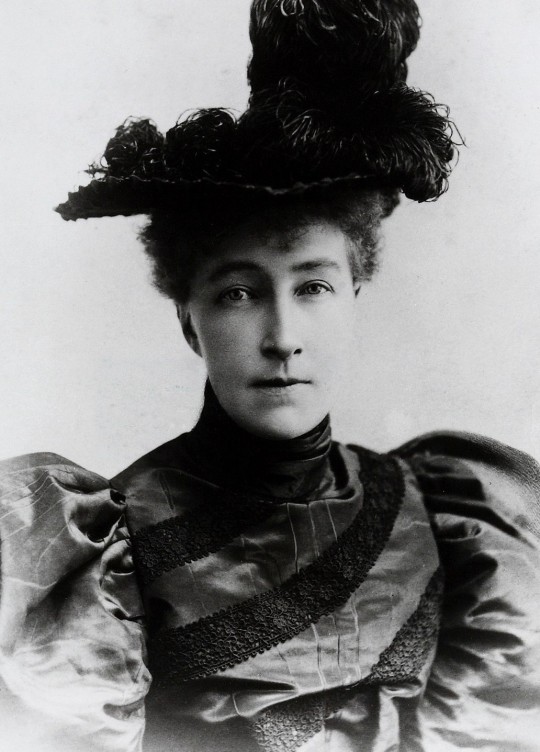

I can recall my last visit, which I paid in my mother’s company during the year 1899. The Empress [Charlotte of Mexico]’s suite was awaiting us in front of the castle and conducted us to her apartments.
There she stood, deathly pale, but still amazingly beautiful. I ran up to her to kiss her hand. She embraced me, obviously delighted to see me once more.
When we had seated ourselves, the Empress began to speak garrulously, but everything she said was confused, for her mind was unhinged.
Suddenly she turned her large dark, sorrow-laden eyes upon me, "Tu viens d’ Autriche, chére enfant? Comment se porte ton beau pére, l'empereur?" ["You come from Austria, dear child? How is your father-in-law, the Emperor?"] she inquired.
Thereupon she rose to her feet, took me by the hand, led me to the life-size portrait of Emperor Maximilian, curtsied humbly before him, and said: "Et l'autre, ils l'ont tué!" ["And the other one, they killed him!"]
It was really heart-breaking.
My mother succeeded, at length, in getting the Empress away from the picture, and begged her to play the piano to us.
I listened, much astonished, at the accuracy of her performance. Music and painting had always been her favourite occupations. She excelled especially at the latter art. I have one of her paintings.
When she had finished playing the piano, she took us into the castle chapel and knelt down.
As I came away from Bouchout after my visit, I had always the same feeling, one of something like fear for the mystery and strangeness surrounding any one suffering from mental disorder, as did this noble Princess.
Princess Stephanie of Belgium (1937). I was to be empress
21 notes
·
View notes
Text
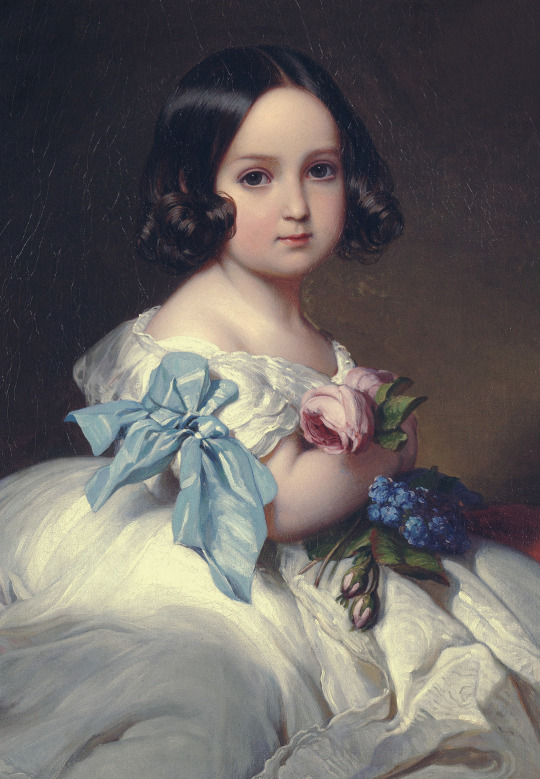
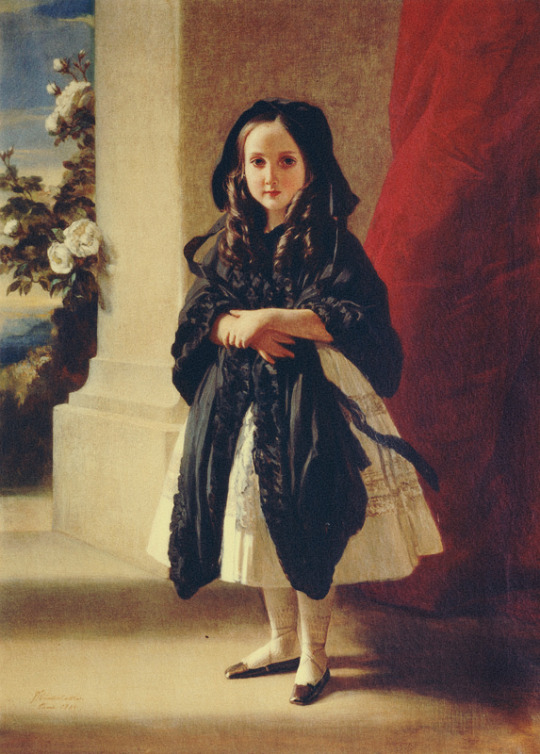
There are several portraits of Charlotte as a child. We see her serious little face with the large dark eyes, looking out from under flowered Leghorn hats, painted in a family group with her two brothers or playing with a pet cat. Winterhalter paid several visits to Brussels to paint the royal children, and his two portraits of Charlotte between the ages of six and ten form a tragic contrast. In the one, she is a petted, demure little girl dressed up in her party silks, a child for whom the world is still a secure and happy place; in the other, she is in mourning, a sad, lost figure in her gray dress and black mantilla, which banishes the look of childhood from her face, a face grown old with tears. Winterhalter, the Court painter par excellence, who made every king a hero and every queen a beauty, succeeds in transferring on to canvas the bleakness of a child's despair. We can envisage the little girl who, only a week after her mother's funeral, when her grandmother had returned to England, wrote: "We were grateful you were with us to share in our grief. But Laeken is a very lonely place now that you have gone. It has been a terrible blow to you, but I will try to be very good to make up to you as far as I can for all that you have lost."
Haslip, Joan (1971). The Crown of Mexico: Maximilian and his Empress Carlota
31 notes
·
View notes